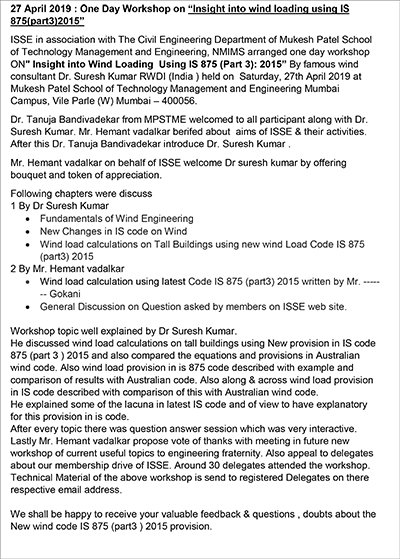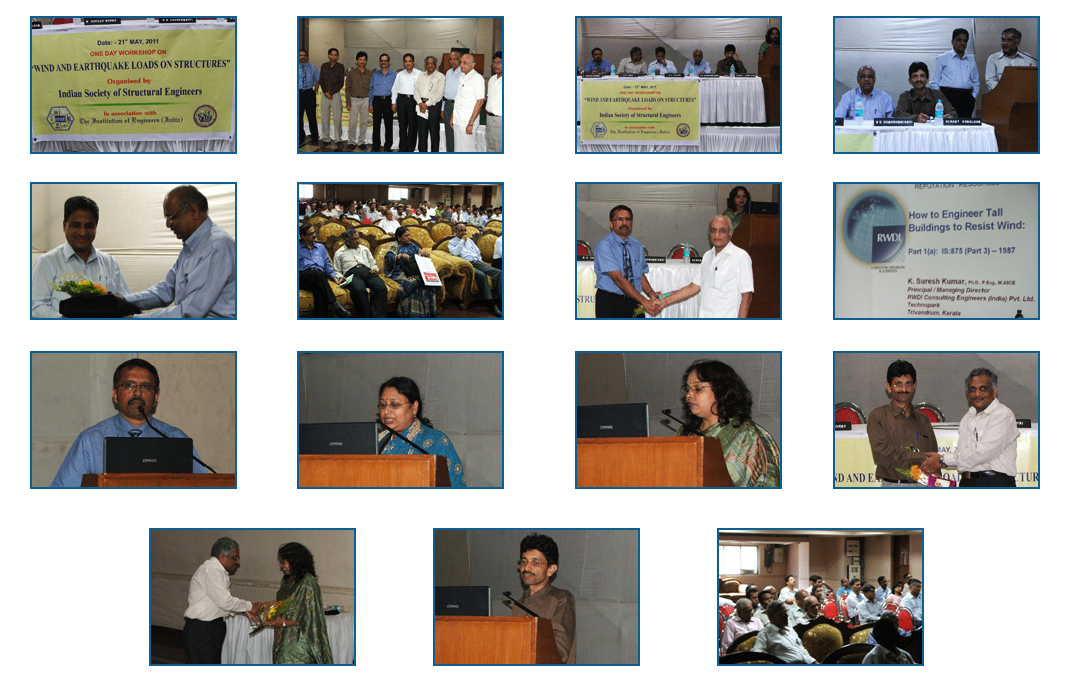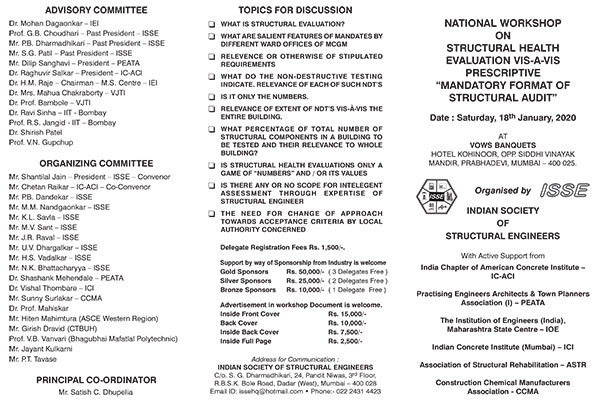PAST EVENTS – WORKSHOPS
| ONE DAY WORKSHOP ON-STRUCTURAL HEALTH EVALUATION VIS-A-VIS PRESCRIPTIVE “MANDATORY FORMAT OF STRUCTURAL AUDIT” |
|---|
| Saturday, 18th January 2020 |
|
|
| ONE DAY WORKSHOP ON-INSIGHT INTO WIND LOADING USING IS875(PART3) 2015 |
|---|
| 27 April 2019 |
 |
| ISSE ONE DAY TOUR ON-SARDAR SAROVAR DAM & STATUE OF UNITY |
|---|
| Saturday, 9th March, 2019 |
 |
| INDIAN SOCIETY OF STRUCTURAL ENGINEERS |
|---|
| Dear Structural Engineers,
Please refer to the notice released by UDD in which BMC will be insisting on defect liability for 10 years on all professionals including structural engineers. Members are requested to send suggestions and objections in large numbers to Deputy Director Town Planning before 8 April 2017 as per the address given. |
| INDIAN SOCIETY OF STRUCTURAL ENGINEERS |
|---|
| 29th December, 2015 |
|
Some architects are insisting on certificates from Structural engineers on quality , workmanship and material testing citing a reference to CE DP circular CHE/DP/49/Gen/2015-16 Dt 29-12-2015. ISSE delegation consisting Mr. D S Joshi- President, Mr. S G Dhamadhikari, Hemant Vadalkar and Chetan Raikar had meeting with CE DPP at MCGM office on 4 Jan 2017. It was clarified by CE DP that such certificates are not asked by MCGM. ISSE members should take a note of this fact. Soft copy of Manual of Building approval Version 1.1 is available on MCGM site. ( WITHOUT PREJUDICE ) SOME INTERPRETATION AS TO APPREHENDED RESPONSIBILITES ON STRUCTURAL ENGINEERS UNDER RERA (REAL ESTATE REGULATIONS ACT) by Satish Dhupelia, Consulting Engineer ,Mumbai. (satishcdhupelia@yahoo.com) Some concerns are raised by some Consulting Structural Engineers, in interpretation of their apprehended Role, within the meaning of “Engineer” under RERA. The clarification are amply available in RERA Act, itself, as to meaning and functions expected of “ENGINEER”, (and not the Structural Engineer on Record.) From all the above it is amply clear that the role of “Engineer” as required under RERA or MAHA-RERA, does NOT expect these functions of “Engineer”, to be of “Structural Engineer”. However, if a concerned “Consulting Structural Engineer” so chooses, to also accept this additional function, distinct and different for that of “Structural Engineer”, he may opt to do so, with full awareness as to various functions expected of “Engineer” as defined under RERA OR MAHA RERA, with resultant consequences upon his accepting the additional function. |
| WIND AND EARTHQUAKE LOADS ON STRUCTURES |
|---|
| 21st May, 2011 |
| Time: 10:00 AM to 5:30 PM
Venue: The Institution of Engineers (India) AC Auditorium, 15, Haji Ali Park, K Khadya Marg, Mahalaxmi, Mumbai: 400 034. About the Workshop “To have an exposure to the intricacies of wind engineering applicable to the structural response of tall buildings, understanding of provision of IS:875 Part3, 1987 Indian Standard for Wind Loads and significance of wind tunnel testing of tall buildings, wind induced motions of cloud structure and key elements for structural design is necessary. ” “Seismic load calculation as per ISI 893 – 2002 and response spectrum analysis in particular will be discussed for tall buildings.” Practical application of Response Spectrum using STAADPro will be presented by Mr. Hemant Vadalkar, Consulting Engineer, Mumbai. Objective The growth of most of the cities in India are without any preplanning and as such rapid urbanization and increase in the density of population are demanding high-rise structures to sustain the growth of commercial activities and high density living accommodations. A large number of these cities are situated in the coastal belt and are vulnerable to cyclonic towns. Design and construction of high-rise structure are ever increasing in the metropolitan cities with economic growth of the country and therefore design of high-rise structures needs more and meticulous attention. In the design of tall structures, the effect of wind induced motions,seismic loading and consequent stress and strain in the structures are of most importance as the lateral loads governed the design. Assessments of wind loading Seismic loading are not that simple to be evaluated as that in a static analysis. The effect of cyclonic wind on a tall structure has to take into account the dynamic behavior of the structure under the varying load. The sphere of understanding has to be spread over a larger section of the professional engaged in design and construction of tall buildings. Hemant Vadalkar ISSE Seminar Co-ordinator . |
 |
| PILE FOUNDATIONS |
|---|
| 20th February, 2010 |
|
To guide structural engineers for efficient planning, analysis , design , detailing and quality control of pile foundations. Foundation is the most important component which directly affects the safety and stability the structure. Pile foundations are commonly used for many civil engineering structures, like buildings, bridges, marine structures etc. Various types of pile like micro-piles, pre-cast bored or driven piles, and steel, bored cast in situ piles are in use for various applications. Bored cast in situ piles are most commonly used. Since the work is done under ground, it is necessary to monitor and record the data for every step in the construction of pile foundations. There are many grey areas in the design and construction of pile foundation. This includes interpretation of soil data, assumption of the sub- grade modulus for different soil layers for design of piles under lateral load, termination depth for friction and end bearing piles. The most crucial aspects is ensuring quality control at site as the construction of piles below the ground cannot be visually inspected. Various aspects of geotechnical parameters modeling of the foundation systems, analysis, detailing, construction aspects, monitoring and quality control at site for pile foundations along with case studies will be discussed during the workshop. Eminent structural and geotechnical engineers like De. N.V.Nayak, Dr.S.Y.Mhaiskar, Dr.V.V.Nori, Mr.S.R.Ambiye, Mr.V.T.Ganpule, Prof.G.B.Chaudhary, , Mr.D.J.Ketkar, Mr. Ravikiran Vaidya will share their experience. |
| LEGAL AND STATUTORY REQUIREMENT FOR STRUCTURAL ENGINEERS |
|---|
| 22nd August, 2008 |
About the Workshop All of us Engineers acquire skill in various subject related to our own field. We get exposure to diverse Engineering fields starting techniques, hydraulics leading to large structures like dams and canals, applied mechanics and strength of materials leading to do as analysis and design of concrete and steel structures of specialized nature and specialized structures. We learn soil mechanics and geo-technical engineering leading to foundation engineering, roads, highways and airports. Many of us specialize ourselves in one or two main fields of in which they had developed some interest and have limited exposure to other related education leading to post graduation and doctorate. Broadly we can make a blanket statement that we are reasonably good at the subject related to Engineering. This works out perfectly well till the time one is serving with some firm or practicing as a free lancer. However the entire curriculum does not give any exposure to other equally important fields viz Accounts and Administration on one side whereas Management, related statutory acts and HRD on the other side. Although all of us do have a genuine desire to practice in a straightforward and lawful manner, many a times a Practicing Engineers is caught on wrong foot because if ignorance. One has to face unpleasant situation and pay fine and penalties almost for no fault of his. This workshop is an effort to give introduction to various causes related to income Tax, Service Tax and the Statutory Acts under which every practitioner is covered. You will get a brief introduction to all this subjects. One need to select his /her own consultant and take their help from time for specific individual requirements. Guidance for effective use of staad pro software . |
| TO GUIDE THE STRUCTURAL ENGINEERS FOR THE EFFCIENT USE OF STAADPRO SOFTWARE WITH SOLVED EXAMPLE |
|---|
| 6th March, 2004 |
About the Workshop Software STAADPro is one of the popular software tools used by the leading Structural Engineers worldwide. It is very useful software for analysis & design. It addresses all the production needs of the Structural Engineer’s office. The core facilities provided in STAASPro include model generation, visualization tools, static & dynamic analysis, steel & concrete design as per Indian and International codes. Objective Many Structural Engineers use this software daily. But due to scarcity of time, many users can not explore all the features. Thus, the full potential of the software is not utilized. Sometimes, mistakes in the input data many lead to erroneous results. The intention of this workshop is to point out and discuss he users, advanced features of the software with simple tricks, so that, the potential of the software is fully utilized. This will improve the productivity in the design office. The topics discussed shall include Common mistakes in data file, Do’s and Don’ts, art of modeling and solutions to common modeling problems. Shear wall modeling, rigid diaphragm action for mat foundation, tension only members, Finite Element technique, dynamic analysis, load generations for wind, moving loads, EQ loads as per a IS 1893-2000 and IS800-1984 provisions. Experts are invited to share their knowledge & experience in the design of various types of projects using STAADPro. Advance features like Dynamic analysis, Finite element analysis will be discussed by the experts. |
| STRUCTURAL AUDIT: METHODOLOGY, GUIDELINES AND RELATED ISSUES |
|---|
| 1st November, 2003 |
About the WorkshopAs per the latest byelaws of co-operative housing societies it is mandatory to carry out Structural Audit of the building of the society. The purpose of such audit is to assess the condition of the building. A well defined methodology for carrying out structural audit is, however, not available. Also, there are many issues and practical difficulties, which stem out from this relatively new requirement. The purpose of the workshop is to present a methodology and guidelines (including model report and forms) for carrying out structural audit. Many important issues from various angles (Technical, Social, Administrative etc) and practical difficulties will also be discussed. Contents of Workshop
|
| SEISMIC DESIGN & DETALLING OF RCC FRAMED STRUCTURES |
|---|
| 23rd February, 2002 |
| About the Workshop
The aim of the workshop is to explain in details the concepts of structural analysis, design and detailing of RCC framed structures for earthquake resistance ,it will be presented by Mr.D.S.JOSHI , a seminar consulting engineer and the chairman of ISSE committee for codes & standards responsible for writing the book “DESIGN OF REAINFORED CONCRETE STRUCTURES FOR EARTHQUAKE RESISTANCE” A former assistant professor of structural engineering at SPCE, Mumbai, Mr.Joshi has been guiding post-graduate students of structural engineering. The workshop will cover the following
|


